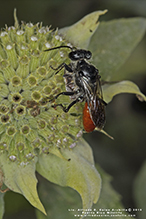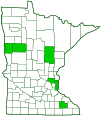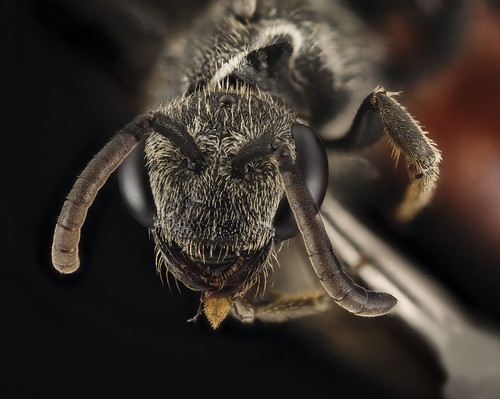buttercup blood bee
(Sphecodes ranunculi)
Conservation • Description • Habitat • Ecology • Distribution • Taxonomy
Conservation Status |
|
|||||||
| IUCN Red List | not listed |
|||||||
| NatureServe | NNR - Unranked SNR - Unranked |
|||||||
| Minnesota | not listed |
|||||||
Description |
||
Buttercup blood bee is a small, kleptoparasitic, sweat bee. It occurs in the United States from Maine to North Carolina, west to North Dakota and Kansas, and in adjacent Canadian provinces. The female is ¼″ (7 mm) in length. The head and thorax are black, the abdomen is bright blood red. This is the feature that gives the genus its common name. The head is entirely black and much wider than long. The compound eyes slightly converge below. The jaws (mandibles) have an inner, dark reddish tooth near the tip (subapical). The tongue is short. The antennae have 12 segments, a scape and pedicel at the base and a whip-like section (flagellum) with 10 segments (flagellomeres). The first flagellomere is very short, much wider than long. The second is as long as wide, twice as long as the first. The remaining segments are slightly longer than wide. The antenna bases are close together. The face is deeply pitted (punctured) and densely covered with silvery hairs. There is just a single line-like groove extending downward from the base of each antenna (subantennal suture). The top of the head (vertex) is somewhat shiny and is densely and finely punctured. The thorax is shiny, entirely black, and densely and evenly punctured. There are branched hairs on the pronotal lobe, but this cannot be seen without a microscope. The abdomen is smooth, shiny, and entirely blood red, with no black at the tip. It has comparatively few widely scattered minute punctures. The front margin of each abdominal segment is broadly indented and yellowish translucent. The wings are mostly translucent, with dark veins, a dark cell (stigma) on the leading edge (costal margin) just before the marginal cell, and a slight brownish tint toward the tip. The marginal cell is pointed but not sharply pointed. The basal vein is strongly arced at the base, like the letter J. There are three submarginal cells. The first cell is about as long as the second and third cells combined. The two outermost veins are well developed. The legs are mostly black. On the front legs the first segment (coxa) is convex below and is not dilated. The last part of each leg (tarsus), corresponding to the foot, has 5 segments. The end segment is paler reddish-black. Since the female does not provision a nest, she has no pollen collecting hairs (scopa). The male is larger, 5⁄16″ (8 mm) in length. The antennae have 13 segments. The second flagellum is about four times as long as the first. The abdomen is more densely and more deeply punctured. The front margin of each abdominal tergum is narrowly indented and is the same color as the rest of the tergum. |
||
Size |
||
Female: ¼″ (7 mm) Male: 5⁄16″ (8 mm) |
||
Similar Species |
||
Habitat |
||
|
||
Ecology |
||
Season |
||
April to July |
||
Behavior |
||
Females can often be seen hovering above the ground in search of a nest of a potential host. |
||
Life Cycle |
||
The female enters the nest of another bee, usually one in the genus Halictus, Lasioglossum, Augochlora, Augochlorella, or Augochloropsis. She kills the host eggs and lays one egg of her own. |
||
Larva Food |
||
|
||
Adult Food |
||
Flower nectar |
||
Distribution |
||||
|
Sources |
|||
| 8/4/2022 | ||||
Occurrence |
||||
|
||||
Taxonomy |
|||
Order |
Hymenoptera (ants, bees, wasps, and sawflies) | ||
Suborder |
Apocrita (narrow-waisted wasps, ants, and bees) | ||
Infraorder |
Aculeata (ants, bees, and stinging wasps) | ||
Superfamily |
Apoidea (bees and apoid wasps) | ||
| Epifamily | Anthophila (bees) | ||
Family |
Halictidae (sweat bees) | ||
Subfamily |
Halictinae (sweat and furrow bees) | ||
Tribe |
Sphecodini | ||
Genus |
Sphecodes (blood bees) | ||
Synonyms |
|||
|
|||
Common Names |
|||
buttercup blood bee buttercup cuckoo sweat bee |
|||
Glossary
Costal margin
The leading edge of the forewing of insects.
Coxa
The first (most proximal) segment of the legs of most arthropods, including all insects, spiders, and crustaceans, and most arachnids. It attaches the leg to the body and connects to the trochanter. Plural: coxae.
Flagellomere
A segment of the whip-like third section of an insect antenna (flagellum).
Scopa
A brush-like tuft of hairs on the legs or underside of the abdomen of a bee used to collect pollen.
Stigma
In plants, the portion of the female part of the flower that is receptive to pollen. In Lepidoptera, an area of specialized scent scales on the forewing of some skippers, hairstreaks, and moths. In other insects, a thickened, dark, or opaque cell on the leading edge of the wing.
Tarsus
On insects, the last two to five subdivisions of the leg, attached to the tibia; the foot. On spiders, the last segment of the leg. Plural: tarsi.
Vertex
The upper surface of an insect’s head.
Visitor Photos |
|||||
Share your photo of this insect. |
|||||
| This button not working for you? Simply email us at info@MinnesotaSeasons.com. Attach one or more photos and, if you like, a caption. |
|||||
Alfredo Colon |
|||||
 |
|||||
MinnesotaSeasons.com Photos |
|||||
|
|||||

Visitor Videos |
|||
Share your video of this insect. |
|||
| This button not working for you? Simply email us at info@MinnesotaSeasons.com. Attach a video, a YouTube link, or a cloud storage link. |
|||
Other Videos |
|||

Created: 8/4/2022
Last Updated:




